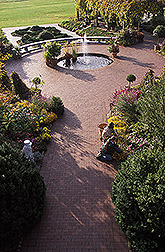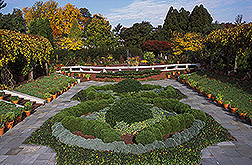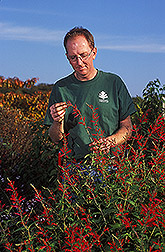The National Herb Garden
|
|
It displays the many ways these diverse plants enhance our everyday lives.
The National Herb Garden, a popular feature on the grounds of the U.S. National Arboretum (USNA) in Washington, D.C., began as a special gift to the people of the United States from the Herb Society of America. Headquartered in Kirtland, Ohio, the society spent 15 years working with the U.S. government and raising matching funds to ensure its completion.
The garden was dedicated in May 1980. Recently, the arboretum embarked on a 6-month celebration of the 25th anniversary of its opening. Says horticulturist Jim Adams, the National Herb Garden’s curator, “We’re very excited. We’ve scheduled many special lectures and demonstrations to help our visitors understand the central role that herbs have played in societies for many centuries.”
Planned by landscape architect Tom Wirth—who was then with Sasaki Associates of Watertown, Massachusetts—this is the largest designed herb garden in North America and includes annual, perennial, and woody herbal plants. Its 2.5 acres are divided into three main sections, one of which is subdivided into 10 specialty gardens. Plants are labeled, and interpretive signs help visitors understand the collection in the context of the herbs’ history and use. A major USNA renovation a few years ago now gives full accessibility to the herb garden via broad paths and gentle inclines.
|
|
An integral part of the arboretum—which pays for 95 percent of the garden’s maintenance and operation costs—the National
Herb Garden is tended by USNA’s Gardens Unit. Staff cultivate an extensive collection of rosemary, lavender, scented geraniums, and salvias that, along with many tropical and subtropical potted herbal plants, enliven the gardens, terraces, and walkways. Each year, Gardens Unit staff grow about 400 varieties of annuals for the herb garden—including 60 to 90 varieties of peppers—and maintain nearly 75 containers of tender trees and shrubs in a greenhouse during winter.
|
|
Gardens Within the Garden
Visitors to the National Herb Garden enter along an herb-lined path to a reception plaza. Its cooling pool and fountain overlook the sunken Knot Garden, named for the intricate pattern into which chains of dwarf evergreen Japanese holly, juniper, and arborvitae have been woven. In the distance rise the Corinthian-style National Capitol columns that graced the east portico of the U.S. Capitol for more than a century.
Next, beyond vine-covered arbors, visitors enter the second section, the Historic and Species Rose Garden. Here bloom many types of “old” roses that existed before 1867. The collection includes more than 100 specimens in categories such as Albas, Bourbons, Centifolias, Chinas, Damasks, Gallicas, Mosses, Noisettes, Teas, and Hybrid Perpetuals. Such roses have long been grown for medicinal and culinary purposes as well as for their beauty and scent.
In the garden’s third section, visitors can familiarize themselves with hundreds of the herbs that have not only enhanced the quality of human life, but also sometimes brought fortunes to growers and traders. They are arranged in discrete, wedge-shaped groupings arrayed around a central circle. In order, they are:
- Dioscorides Garden– medicinal herbs from a pharmacopoeia compiled by the Greek physician Pedanius Dioscorides. At around A.D. 60., he collected hundreds of plant, animal, and mineral specimens from along the Mediterranean seacoast and described them in a reference that was respected in the profession for the next 1,600 years. Today’s aspirin is a synthetic copy of the compound from a white willow tree studied by Dioscorides, who noted that juices from its bark and leaves eased colds’ aches and fevers.
- Dye Garden– herbs mainly used to color fabric and textiles, though many plants serve multiple dye functions. For thousands of years, plants have been used to color everything from hair, skin, and clothing to baskets, medicine, and food. Plant dyes have also embellished living and sacred spaces.
- Colonial Garden– practical herbs that were largely brought from the Old World by early settlers to flavor their food, improve their nutrition, cure their ills, repel pests, and enhance fabrics for clothing and households.
- Native American Garden– herbs traditionally valued by native North Americans as food, beverages, medicines, dyes, and charms—as well as for smoking. Early European colonists soon adopted many of these plants and uses.
- Medicinal Garden– herbs used for healing from the time of ancient medicinal herbalism to development of synthetic drugs that mimic herbs’ active constituents. Even today, about 40 percent of prescription drugs contain herbs, and pharmaceutical companies scour the world for potential new plant sources.
- Culinary Garden– herbs widely used as both food and flavoring. In small quantities, these can add color, character, and interest to nearly any dish, and they can be combined in about as many ways as there are cooks. They add healthful nutrients, too.
- Industrial Garden– plants that might become renewable sources of raw materials for industrial products. Increasingly, plants are being scrutinized or modified for usable constituents, such as waxes or resins. Converting plants into fuels, insecticides, lubricants, rubber, fibers, or other industrial materials could give farmers higher value alternative crops and lessen dependence on petroleum-based products.
- Fragrance Garden– herbs typically used—some for at least 4,000 years—as perfume or to provide fragrance in homes and places of worship.
- Oriental Garden– herbs mainly from Japan, China, and Korea that have been used for thousands of years in cosmetics, dyes, flavorings, medicines, and industry.
- Beverage Garden – herbs used for teas, liqueurs, and other drinks. In addition to coffee and tea, many consumers also enjoy teas brewed from chamomile, lemon balm, peppermint, and other flavorful herbs.
U.S. National Arboretum director Thomas S. Elias says that the herb garden is an excellent reminder of the many plants—herbs and flowers, as well as shrubs and trees—that have long been valued in America’s gardens, farms, public spaces, and wild places.—By Alfredo Flores, Agricultural Research Service Information Staff.
This project is part of Plant, Microbial, and Insect Genetic Resources, Genomics, and Genetic Improvements, an ARS National Program (#301) described on the World Wide Web at www.nps.ars.usda.gov.
James R. Adams is curator of the National Herb Garden, U.S. National Arboretum, 3501 New York Ave., N.E., Washington, DC 20002-1958; phone (202) 245-5967, fax (202) 245-5973.
"The National Herb Garden" was published in the May 2005 issue of Agricultural Research magazine.









